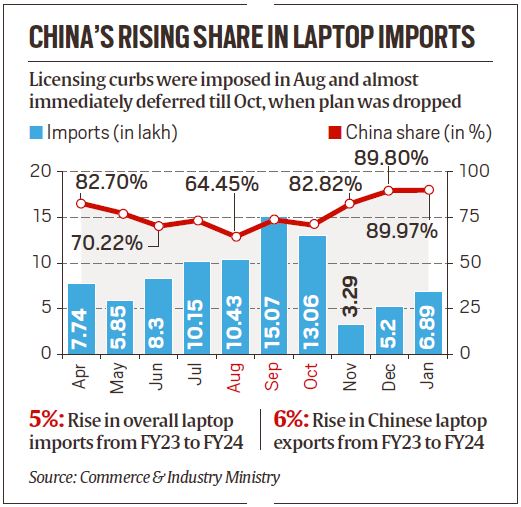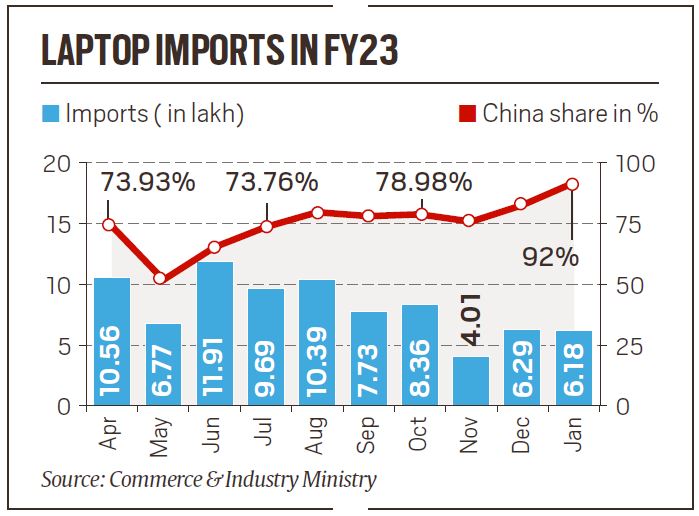In January, nearly 90 per cent of the laptops and personal computers (PCs) imported by India came from China. In the month before that, Beijing’s share was well over 89 per cent and, in November, the figure was 83 per cent. In all, until January in the 2023-24 financial year (FY), nearly eight out of 10 laptops sold in India came from China, shows an Indian Express analysis of the Commerce Ministry’s import-export data bank.

And yet, India’s total laptop imports went up 5 per cent year-on-year in FY24 (until January), while such imports from China increased 6 per cent. In quantitative terms, China exported 64.93 lakh units to India in FY24 compared to 61.24 lakh units in FY23. January is the latest month for which the data for this category (HSN: 84713010) is available with the ministry.
The data shows that the immediate reaction by companies to the DGFT licence restriction, and the almost immediate postponement of the plan till October 31, was to quickly stock up on inventory. And after October, when the government revoked the import licence plan, total imports fell amid high stocks — but China’s share in the overall pie grew considerably.

Between April and July 2023, before DGFT’s notification, China’s average share in imports was close to 76 per cent. Between August and October, amid uncertainty around the deferred notification, China’s share came down to around 70 per cent. From November 2023 to January 2024, after the licence plan was dropped, Beijing’s share in imports of the goods shot up to 87.5 per cent.
These developments came even as the US, aiming to protect American companies such as Apple, Dell and HP, stepped up efforts to discourage the Indian government from imposing strict laptop import restrictions.
In August, when the import restriction notification was issued and postponed a day later by the DGFT, around 10.43 lakh laptops and PCs were imported to India. Of these, China accounted for 6.7 lakh, or roughly 64 per cent. This was a rare decline in China’s share of total laptop imports to India. In the same month, imports from Singapore saw a bump as it exported close to 2.56 lakh units to India.

Story continues below this ad
Industry executives explained that the reason behind the spike in Singapore’s numbers came because in the uncertainty that accompanied the DGFT notification and its deferment, companies moved some of the billing and exports to the island nation, which is a global trading hub for a number of electronics manufacturers.
At the time, The Indian Express had reported that companies such as Apple and Samsung had frozen imports from China until further clarity and that the government put off the curbs amid intense industry pushback.
Meanwhile, companies shored up their inventory, with laptop imports showing a big spike in September. A total of around 15 lakh units made their way into the country that month and China accounted for more than 11 lakh units — close to a 74-per cent share.
Similarly, in October, China accounted for around 71 per cent of India’s total laptop imports, exporting over 9 lakh pieces of the total 13 lakh. September and October also precede the festival of Diwali, when consumers typically purchase laptops and PCs.
Story continues below this ad
By the time the government dropped the licence restriction plan and introduced the import management system on October 20, companies had stocked their inventory to the brim.
The next month, overall laptop imports saw a sharp decline, with around 3.3 lakh units coming to India. China’s share of the total, however, jumped to nearly 83 per cent as it accounted for 2.72 lakh pieces — a trend that solidified in the next two months.
In December, India imported around 5.2 lakh laptops (worth around $276 million) and China commanded a lion’s share of these at 89 per cent, or 4.67 lakh units. In January, China’s share grew even further: India imported 6.9 lakh laptops of which 6.2 lakh, roughly 90 per cent, came from China.
While it is worth noting that FY23, too, saw a somewhat similar decline in imports in November, December and January, the quantity of imports in September and October, the pre-Diwali months, was much higher in FY24.
Story continues below this ad
China’s share was 92 per cent, in January 2023 as well, but that was not preceded by government efforts to discourage Chinese imports.
The trend comes at a time the government’s production-linked incentive (PLI) scheme for IT hardware is understood to be moving in the slow lane, despite the Union Information Technology Ministry modifying the plan to increase budgetary outlay last May, and clearing 27 entities, including Acer, Asus, Dell, HP and Lenovo, under the scheme.
“The government had asked companies to come back with production targets under the scheme but they are yet to receive detailed projections by them despite repeated efforts,” an industry source aware of the discussions said, requesting anonymity.
As part of the import management system brought in place of the licensing requirement, manufacturers are required to disclose data related to the quantum of their imports and countries from which they import, among other things.
Story continues below this ad
“The government has indicated that until September 2024, it will allow companies to import as many laptops and computers as they want without imposing a cap or restrictions. The companies are hopeful that they can push the government on that timeline further and keep importing, which in a way, also disincentives them to prioritise the IT hardware PLI,” a senior government official said, requesting anonymity.
Queries sent to the Commerce and IT ministries remained unanswered at the time of publication.
“Under pressure from the US, India continued to allow imports without announced restrictions. This promoted imports and delayed domestic production. The US has a confusing China policy. By imposing trade restrictions on semiconductors and other select products, the US aims to safeguard its technological and economic interests. Yet, it baulks when similar measures are taken by other countries as they threaten to impact American companies’ profits,” said Ajay Srivastav, a former trade officer and founder of the Global Trade Research Initiative.
“The jump in imports after the laptop licensing regime was announced could be a panic reaction. The Chinese could have increased the discounts… that cannot be ruled out. Manufacturing laptops in India is a challenge as there is a case of inverted duty structure…” said Ajay Sahai, Director General, Federation of Indian Export Organisations.
Story continues below this ad
As per the commitment made under the Information Technology Agreement in 1997 at the World Trade Organisation, India cannot increase the duty on laptops, PCs and similar IT products, which currently come into the country at zero duty. China is the largest exporter of PCs and laptops in the world, with a dominant share of 81 per cent. In 2022, China’s global exports of these items stood at $163 billion. Top firms such as Lenovo, Apple, Dell and HP make most of their laptops and PCs in China.
“The case for local laptop manufacturing in India is compelling. China dominates the PC and laptop market with an impressive 81 per cent share. In case of any production disruption in China, the whole world will suffer. In this context, India’s efforts to bolster local production of mobile phones, laptops, etc are in the right direction. However, India must avoid incentivising superficial assembly operations,” Srivastav said.



































